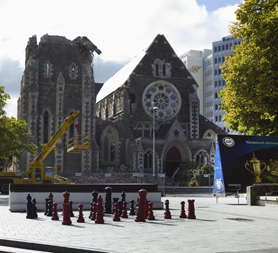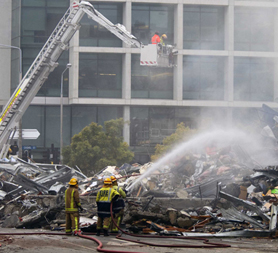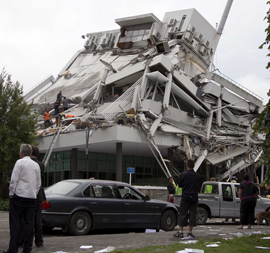New Zealand quake: ‘Death toll could exceed 200’, says PM
The New Zealand Prime Minister, John Key, says the death toll from the Christchurch quake could climb above 200, with at least that figure still missing and 98 already confirmed dead.
As the search for survivors in Christchurch goes on into the night, the death toll keeps on rising and the first official British victims have been announced.
The Foreign Office confirmed that two UK citizens had been found amidst the rubble as the official total for those killed rose to 98, with the figure expected to escalate by Friday with more than 200 people still missing, most of them presumed dead.
The collapse of the Canterbury Television Centre, completely destroyed by the earthquake, is believed to have claimed 120 victims including at least 10 Japanese students.
The search at the TV Centre has now become a recovery mission, with no life signs found after thermal imaging equipment, sound detectors and sniffer dogs were used on site.
The Prime Minister said he believed that the death toll would rise to over 200 and the number injured is as high as 2,500. Medical officers in Christchurch have said that 164 people have serious injuries ranging from spinal injuries to broken bones.
City Mayor Bob Parker refused to give up hope for more survivors however: “Miracles happen and we’re keeping that in the forefront of our minds. That sort of thing drives you and pushes you on.”

Rescue sites across Christchurch
The Cathedral building has become the tragic icon of the Christchurch quake. The main spire of the building fell to the ground and is believed to have crushed tens of people. The ‘English-style’ brick building was highlighted as an at-risk building because of its lack of anti-earthquake measurements. Between 16 and 22 people are presumed to have been killed by the damage caused to the historic building, whilst videos from the site show statues surrounding the church have fallen from their plinths.

The CTV building is the site where most of the missing people are presumed to be and where the greatest loss of life is being recorded. As many as 120 people are missing presumed dead and the search for survivors was all but conceded on Wednesday when it was declared that the mound of rubble was “100 percent unliveable”. Popular Canterbury TV presenter and producer Donna Manning is believed to have been amongst the dead.

The Pyne Gould Guinness building is one of the bases of a New Zealand-based building society. The building collapsed under the stress of the earthquake that struck around midday, the worst possible time, crushing as many as 20 people, according to police. Rescue operations continue here, however and it is considered one of the sites most likely to find survivors. The building did not collapse as completely as the TV centre, and screams could be heard from scores of trapped victims on Tuesday. Most of these people were successfully rescued but contact has not been made in the wreckage with those still missing.
Redcliffs, a suburb of Christchurch, was evacuated after fears that a cliff face would collapse. With after-shock occurences now well over 50, as well as the much talked-about softness of the ground in Christchurch, the cliff is at risk of crushing a number of homes and buildings. More aftershocks are expected as the volatile fault line continues to be a major earthquake risk.
Why Christchurch was struck so soon after September’s quake
The earthquake on Tuesday measured 6.3 on the Richter Scale, one notch lower than the quake in September 2010, but the shallow depth and the location of the epicentre being so close to the major city meant that the devastation was far worse than could have been expected.
Seismologists generally expect a large aftershock on a fault line similar to this week’s event within six months of a major quake. However, the location, building structure, ground conditions and time of day that the quake struck have all contributed to make it one of the most devastating in recent years.
Up until September, Christchurch was considered one of the safest places in what is an earthquake-prone country. The fault line revealed by these major quakes and hundreds of minor aftershocks was unknown and may have not been disturbed in over 10,000 years.